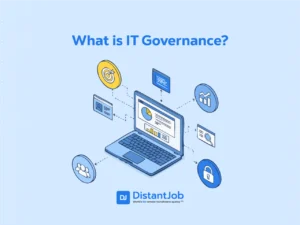Since last March, companies have been experimenting with solutions to adapt to the global restrictions in travel and social life – which basically meant translating everything to remote mode.
As the first answer to the global lockdown, these transitions are still happening. In many cases, flexibility and remote solutions helped productivity by widening the talent pool. In other instances, that same flexibility became one more issue to deal with. When it comes to the hiring process, some see remote work as an extra financial cost, or worse – a waste of time.
After almost a year, there are still questions on how to simplify the remote hiring process. There is not a simple way to answer these questions. At DistantJob, we are specialists in fully remote hiring processes. Even before it was mainstream, DistantJob has been supporting companies by helping them hire the best talent from all around the world. Over more than a decade, we collected some insights to make your transition as easy and effective as possible.
5 Steps to Transition from Local to Remote Hiring
1. Don’t Copy: That’s Not How Remote Hiring Processes Work
A few months after the first lockdown, Jack Dorsey (Twitter’s co-founder and current CEO) announced that his employees could work permanently from home even after the end of the pandemic. Since last March, Twitter employees – over 4900 people – can decide whether they want to work from home or in the office. According to Dorsey, lockdown months proved that remote work actually works and so it’s worthwhile to keep exploring solutions to combine on-site and remote tasks. Why was this transition so successful for them?
To make this transition happen, a superficial transfer of their values and workflow wouldn’t have worked. By superficial transfer, I mean a transformation that doesn’t start within the company’s culture. Even with a strong and close-knit team, adding a new remote hire demands new modes of organisation and communication. To keep the rhythm going, think as if every member of your team is remote. What was working in an office might not be so effective online.
Define your company roles thinking of the new necessities in remote mode. If you are moving to a hybrid team or a fully remote company, a good first step is to write basic info for each role. Talk to your team and teach people where to find what they need, rather than hand them handbooks. Go through this process even if you think this transition is just temporary.
Remote teams don’t only need different channels of communication but also different internal structures to work together. Especially when looking for new hires, make sure you know what you want, how and where to communicate it. Each team is unique as well as each company structure. What they all look for is clarity. Make decisions, daily tasks, deadlines and stick to it.
2. Prepare Your Team for the Main Steps in the Hiring Process
Before writing down your job description, have a briefing with your team. First, you need to adjust every step of your current hiring process to the remote setting. Especially if you are transitioning, even the most casual follow-up needs to be communicated – and documented. Hiring processes are tedious, especially for a company transforming its internal structure. Einstein used to say that the best ideas come in times of crisis. Well, a full remote hiring process probably won’t make you a genius in the end. On the flip side, it is a great chance to unify your communication and information channels.
Before interviewing for a new member, provide your team with documents, reports and guidelines to follow the interview process. I agree documenting each step of the hiring process can sound boring. But documenting remote work does help you and your team to keep track of what is happening, removing the need to repeat several conversations.
Now, it is time to write down the characteristics of the person you want. To select the right candidate, you need to define roles and responsibilities that come with being on your team. Especially in the pre-interview stage, define the selling points of your remote role. Wonder on what makes a candidate a good fit, which skills are most important to you, if you are looking for a new approach or expertise. Also, discuss salary range and target start date. Keep in mind different time zones and if you will need to keep certain tasks synchronized. Everything will make your team on track and ready for the hiring process.
3. Simplify the Hiring Process
Even the greatest journeys start with a first step. And here, everything starts with the job description. Make your job description as professional as you can, explaining what the position is about and which skills it requires. Also, this is the time when translating your company’s values to a remote setting comes handy.
Let’s look at Twitter once again. Twitter is a huge and busy company, with open space and shared offices meant to let your creativity explode. When transferring to remote, they didn’t just change communication channels, but changed the internal structure to promote team conversations as a part of their core values even in a remote setting.
For Twitter working from home never meant working alone, and that’s what they pushed to make their team feel together even from distance. So, when writing your job description, highlight what is crucial for your company mission, even in a remote setting. If you describe your company vision in a way that makes visible what the new candidate will do, only the most relevant ones will come to you.
This happens not because you are so special or the only open position on the market. It will happen because you communicated your values in a way that made people care not only about the job, but also about the project. That’s what you actually want, because with passionate people, distance is never a problem.
Now, it is time for the CVs. Before the interview process, CVs give you an overview of your talent pool and a first impression for each candidate. If you know how to analyze them, you won’t waste time with useless interviews. At DistantJob, we always put extra care in checking the details on each CVs we share with our clients. Even before an interview, a careful analysis can guide you in picking not only good people for the job but the right people for your company. If you find a CV that looks like a good match, you can always confirm your impression by asking for references. As an alternative, assign the candidate a small project, relevant to the position you’re hiring for.
4. The Interview Process
Finally, interview time. Remote recruitment agencies like ours can help you with selecting and interviewing professionals. At DistantJob, to spot the perfect candidate we put a lot of care and attention in the interview process. This process, even with team interviews, is crucial to making the right choice.
Now, remember that the principle of any good translation is never to imitate another language. It’s always more about learning how “to be” in another language. That’s what you have to do. Online interviews can be a horrible experience. But they don’t have to be like that – if you don’t try to imitate the office experience.
Meeting people in person always gives you a different feeling, but talking to someone on video can also give you an idea of who you are talking to. If you cannot rely on body language, you can look at how the person is talking and presenting past experiences. If you’ve put the effort into creating a relaxed environment, the conversation will go more naturally than you expect. When you meet the right person, it’s not going to be the fact that you are interacting through a screen that will keep you distant or disconnected.
Just make sure you have the right technologies in place – this is the first step to stick with the schedule you have in mind!
5. Onboarding After a Fully Remote Hiring Process
This is the last challenge, and perhaps the hardest. If you want to make your new hire part of your team, onboarding is the key. For us at DistantJob, this is the most important step of the whole hiring process.
So, before hiring your new entry, you had a brief with your team to make sure about communication and task monitoring. When onboarding time comes, make sure to have everything ready. From contracts to passwords and logins, focus on the essential aspects so that all the useful things can be in the right place at the right time.
Especially over the first week, spend time on tools. When it will be wartime, you want all your soldiers ready for the fight. So, make sure to explain which tools your team are using for communication and operativity, how they function and when they need to be available for you.
Remote Hiring and Culture
Last but not least, make your new hire feel involved with your company culture. As we said, people get passionate when they feel part of a mission, not because they just got a job. This is where you rely on your team, because no-one is better than them to share your company beliefs and values on the day-to-day work. So facilitate team meetings, moments to bond or hang out, set up online game nights – whatever comes to your mind.
What really matters is making your new hire feel part of the family. Plus, if you haven’t found the right person yet, we are here to help! Since our very inception a decade ago, we have been closely working with our clients to help them transition to hybrid or fully remote businesses – and we still have more tips to share!





